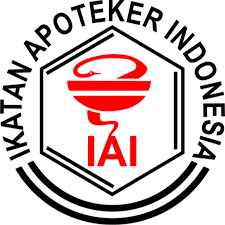Aktivitas Sitotoksik Ekstrak Etanol, Fraksi Etanol-Air, Etil Asetat serta N-Heksana Buah Pare (Momordica charantia) pada Sel MCF-7 secara In-Vitro
Adhe Retnantya Pamungkas(1), Peni Indrayudha(2*)(1) Fakultas Farmasi, Universitas Muhammadiyah Surakarta, Jl A Yani Tromol Pos I, Pabelan, Kartasura, Sukoharjo 57162
(2) (SCOPUS ID:57204616049), Faculty of Pharmacy universitas Muhammadiyah Surakarta, Indonesia
(*) Corresponding Author
Abstract
Keywords
Full Text:
PDFReferences
Afifah U.N., 2017, Uji Aktivitas Atidiabetes Ekstrak Etanol 96% Buah Pare (Momordica charantia L.) terhadap Tikus Jantan Galur Wistar yang Diinduksi Aloksan, Publikasi Ilmiah, Fakultas Farmasi Universitas Muhammadiyah Surakarta
Ainia N., 2017, Uji Fitokimia Infusa Pekat Buah Pare (Momordica charantia L.) dan Pengaruh Lama Terapi dengan Variasi Dosis Terhadap Penurunan Kadar Glukosa Darah Tikus (Rattus norvegicus) yang Diinduksi Aloksan, Skripsi, Central Library of Maulana Malik Ibrahim State Islamic University of Malang
Andersen Ø.M. and Markham K.R., 2005, Flavonoids: Chemistry, Biochemistry and Applications, CRC Press Taylor & Francis Group, New York.
Arnani M., 2018, Obat Kanker Dihentikan Penjaminannya, Ini Jawaban BPJS Kesehatan - Kompas.com, Kompas Media Terdapat di: https://megapolitan.kompas.com/read/2018/07/18/07000081/obat-kanker-dihentikan- penjaminannya-ini-jawaban-bpjs-kesehatan [Diakses pada February 5, 2019].
Budrat P. and Shotipruk A., 2008, Extraction of Phenolic Compounds from Fruits of Bitter Melon (Momordica charantia) with Subcritical Water Extraction and Antioxidant Activities of These Extracts, Chiang Mai Journal of Science, 35 (1), 123–130.
Comşa Ş., Cîmpean A.M. and Raica M., 2015, The Story of MCF-7 Breast Cancer Cell Line: 40 Years of Experience in Research, Anticancer Research, 35 (6), 3147–3154.
Dandawate P.R., Subramaniam D., Padhye S.B., Anant S., Physiology I., City K., City K., City K. and Campus A., 2017, Bitter Melon: A Panaceae for Inflamation and Cancer, HHS Public Access, 14 (2), 913–945.
Departemen Kesehatan Republik Indonesia, 2013, Formularium Nasional 2013, Dalam Departemen Kesehatan Republik Indonesia, Jakarta, pp. 1689–1699.
Farnsworth N.R., 1966, Biological and Phytochemical Screening of Plants, Journal of Pharmaceutical Sciences
Fodor, T., Szántó, M., Abdul-Rahman, O., Nagy, L., Dér, Á., Kiss, B. and Bai, P., 2016. Combined treatment of MCF-7 cells with AICAR and methotrexate, arrests cell cycle and reverses Warburg metabolism through AMP-activated protein kinase (AMPK) and FOXO1. PLoS One, 11(2), p.e0150232.
Chen, C.R., Liao, Y.W., Wang, L., Kuo, Y.H., Liu, H.J., Shih, W.L., Cheng, H.L. and Chang, C.I., 2010. Cucurbitane triterpenoids from Momordica charantia and their cytoprotective activity in tert-butyl hydroperoxide-induced hepatotoxicity of HepG2 cells. Chemical and Pharmaceutical Bulletin, 58(12), pp.1639-1642.
Huang H.L., Hong Y.W., Wong Y.H., Chen Y.N., Chyuan J.H., Huang C.J. and min Chao P., 2008, Bitter Melon (Momordica charantia L.) Inhibits Adipocyte Hypertrophy and Down Regulates Lipogenic Gene Expression in Adipose Tissue of Diet-Induced Obese Rats, British Journal of Nutrition, 99 (2), 230–239.
Jia S., Shen M., Zhang F. and Xie J., 2017, Recent Advances in Momordica charantia: Functional Components and Biological Activities, International Journal of Molecular Sciences, 18 (12)
Junedi S., Sarmoko, Ikawati M. and Meiyanto E., 2009, Prosedur Tetap Panen Sel, (CCRC) Cancer Chemoprevention Research Center Farmasi UGM, 1–3.
Kementrian Kesehatan Republik Indonesia, 2018, Panduan Pelaksanaan Hari Kanker Sedunia 2018, Jakarta.
Liaw C.C., Huang H.C., Hsiao P.C., Zhang L.J., Lin Z.H., Hwang S.Y., Hsu F.L. and Kuo Y.H., 2015, 5β,19-Epoxycucurbitane Triterpenoids from Momordica charantia and Their Anti- Inflammatory and Cytotoxic Activity, Planta Medica, 81 (1), 62–70.
Putri H., 2013, Protokol Uji Sitotoksik Metode MTT, CCRC (Cancer Chemoprevention Research Center) Fakultas Farmasi UGM, 1–8.
Raina K., Kumar D. and Agarwal R., 2016, Seminars in Cancer Biology Promise of Bitter Melon (Momordica charantia) Bioactives in Cancer Prevention and Therapy, Seminars in Cancer Biology, 40–41, 116–129. Terdapat di: http://dx.doi.org/10.1016/j.semcancer.2016.07.002.
Richmond R.A., Vuong Q. V. and Scarlett C.J., 2017, Cytotoxic Effect of Bitter Melon (Momordica charantia L.) Ethanol Extract and Its Fractions on Pancreatic Cancer Cells in vitro, Exploratory Research and Hypothesis in Medicine, 2 (4), 1–11. Terdapat di: http://www.xiahepublishing.com/ArticleFullText.aspx?sid=2&jid=2&id=10.14218%2FERHM.2017.00032.
Saifudin A., 2014, Senyawa Alam Metabolit Sekunder Teori, Konsep, dan Teknik Pemurnian, Deepublish.
Sudoyo A., 2017, Melantun Kebersamaan Berantas Kanker, Yayasan Kanker Indonesia, 69.
Supraja P. and Usha R., 2013, Antibacterial and Phytochemical Screening from Leaf and Fruit Extracts of Momordica charantia, International Journal of Pharma and Bio Sciences
Thomasset S.C., Berry D.P., Garcea G., Marczylo T., Steward W.P. and Gescher A.J., 2007, Dietary Polyphenolic Phytochemicals - Promising Cancer Chemopreventive Agents in Humans? A Review of Their Clinical Properties, International Journal of Cancer, 120 (3), 451–458.
Vishwanath, Shobha Cr P., Mn S., Prashant A. and Rangaswamy C., 2015, In Vitro Anti ‑ Cancer Activity of Ethanolic Extract of Momordica charantia on Cervical and Breast Cancer Cell Lines, International Journal of Health and Allied Sciences, 4, 210–7.
Wang X., Sun W., Cao J., Qu H., Bi X. and Zhao Y., 2012, Structures of New Triterpenoids and Cytotoxicity Activities of the Isolated Major Compounds from the Fruit of Momordica charantia L., Journal of Agricultural and Food Chemistry, 60 (15), 3927–3933.
Wardhani L.K. and Sulistyani N., 2012, Uji Aktivitas Antibakteri Ekstrak Etil Asetat Daun Binahong (Anredera scandens (L.) Moq.) terhadap Shigella flexneri Beserta Profil Kromatografi Lapis Tipis, Jurnal Ilmiah Kefarmasian, 2 (1), 1–16.
Yin, J., Zhang, H. and Ye, J., 2008. Traditional Chinese medicine in treatment of metabolic syndrome. Endocrine, Metabolic & Immune Disorders-Drug Targets (Formerly Current Drug Targets-Immune, Endocrine & Metabolic Disorders), 8(2), pp.99-111.
Zahrah A., Kusmardi and Sunaryo H., 2018, Uji Sitotoksisitas Fraksi Etil Asetat Ekstrak Etanol 70% Buah Pare (Momordica charantia L.) terhadap Sel HeLa, Farmasains, Fakultas Farmasi dan Sains Universitas Muhammadiyah Prof. Dr. Hamka
Article Metrics
Abstract view(s): 2153 time(s)PDF: 2653 time(s)
Refbacks
- There are currently no refbacks.








